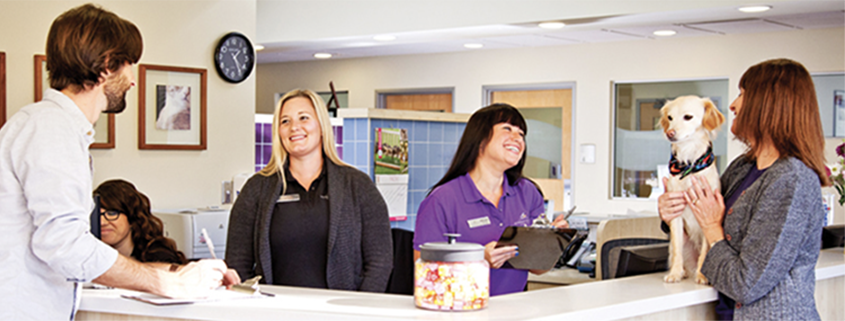Clinical communication skills in veterinary practice
Linda Fineman, DVM, DACVIM (Oncology)
Ethos Veterinary Health, Inc., Colorado State University, Washington State University
Posted on 2017-03-07 in Client Care
Why bother learning clinical communication skills? The goal is improved clinical performance.1
- It produces a more effective consultation between client and veterinarian
- Effective communication facilitates getting accurate information (history, client goals and philosophy…) which leads to better problem-solving) and improves efficiency
- Improves job satisfaction, leading to increased retention, less burn-out or compassion fatigue
- Increases client adherence to medical recommendations
- Increases client satisfaction
“Effective client communication bridges the gap between evidence-based medicine and the individual client/patient.”1
Core Skill #1: Non-verbal communication
Non-verbal communication encompasses all the behavioral signals that go on between people interacting, except what is stated verbally. One every day example of how non-verbal communication skills are used is in the way we read the body language of the animals we interact with. Non-verbal communication is a foundation for effective relationship building with clients. In order to translate this skill to clients, the focus shifts to increasing sensory acuity through heightened attention to non-verbal communication in clients and in ourselves. In a practical sense, this means following up on observations with a verbal check-in and working to enhance our self-awareness. One valuable tool is to consciously add a pause into the flow of a client interaction, allowing them to have freedom to speak without interruption. Studies have shown that veterinarians interrupt their clients in 15.2 seconds3 on average, and physicians do so within 12 to 18 seconds.6-8 Not only does that interfere with efforts to gain trust and relationship-build with our clients, but it also leads to increased time in the exam room as clients don’t have the opportunity to express their concerns and their perspectives until we are walking out the door.
Core Skill #2: Asking open-ended questions
Open-ended questions encourage the person to tell the story or elaborate without us shaping it or focusing the content. The technique involves a “funnel approach”, starting with an open-ended question to gain a broad idea of the array of client concerns, including medical and social factors which may impact decision making. Close-ended questions may then be used to clarify specific points. In one study, not eliciting client concerns at the beginning of the interview increased the odds of a concern arising during the closing segment by 4-fold, 3 leading to longer appointments and less satisfied clients.
Core Skill #3: Showing empathy
Empathy is the ability to see something from someone else’s perspective. Empathy statements name and appreciate another person’s predicament or point of view. A technique to practice is the inhale-exhale technique,4 which consists of listening to the story (inhale) and reporting your understanding (exhale) of the situation. In the first part (the inhale) listen carefully to the person’s thoughts, feelings, and values, and imagine what it would be like to stand in their shoes. In the second part (the exhale), use both verbal and non-verbal communication to demonstrate that you fully understand. Showing empathy is a key part of relationship building and garnering trust. In talking with clients, an actual expression of empathy is uncommon, shown in one study, to occur in only 7% of veterinary appointments!5
Next steps
How do we move forward? Communication skills are just like any other technical skill: they take practice! The concept of “kaizan” is about continuous growth, learning and improvement. Unlike learning to place an IV catheter, or any another technical skill, communication skills are always a work in progress and we are all life-long learners. Taking one skill at a time and committing to work on it will help to keep continued progress. Creating a specific plan will help us hold ourselves accountable to the commitment.
References
- Skills for Communicating with Patients, Third Edition. Silverman, J; Kurtz S; Draper, J. 2013
- Calgary-Cambridge Communication Guide, in Skills for Communicating with Patients, Third Edition. Silverman, J; Kurtz S; Draper, J. 2013
- Dysart, Coe and Adams; 2011
- Institute for Healthcare Communication, Bayer Animal Health Communication Project
- Shaw, Adams, Bonnet and Roter; 2004
- Beckman and Frankel 1984
- Marvel et al 1999
- Rhoads et al 2001
Additional Resources
- FRANK communication courses through Colorado State University
- International Conference on Communication in Veterinary Medicine
About the author
|


 Dr. Fineman has 20 years of experience in specialty and emergency private practice. In addition, she was a practice owner of a 60 veterinarian multi-specialty practice in the Bay Area of California. After relocating to Denver, Colorado, Dr. Fineman was Medical Director at VCA Alameda East, a 45 doctor practice. Dr. Fineman is an Adjunct Professor at Washington State University, where she spends time each year working with sophomore veterinary students in their introduction to clinical problem-solving and client communication using simulated cases. She also works with Colorado State University as a coach in the junior clinical communications lab and the FRANK communications training program. Dr. Fineman lives in Denver, Colorado, with her husband, two cats, a Doberman, and six chickens. She enjoys international travel, bird-watching and hiking.
Dr. Fineman has 20 years of experience in specialty and emergency private practice. In addition, she was a practice owner of a 60 veterinarian multi-specialty practice in the Bay Area of California. After relocating to Denver, Colorado, Dr. Fineman was Medical Director at VCA Alameda East, a 45 doctor practice. Dr. Fineman is an Adjunct Professor at Washington State University, where she spends time each year working with sophomore veterinary students in their introduction to clinical problem-solving and client communication using simulated cases. She also works with Colorado State University as a coach in the junior clinical communications lab and the FRANK communications training program. Dr. Fineman lives in Denver, Colorado, with her husband, two cats, a Doberman, and six chickens. She enjoys international travel, bird-watching and hiking.








